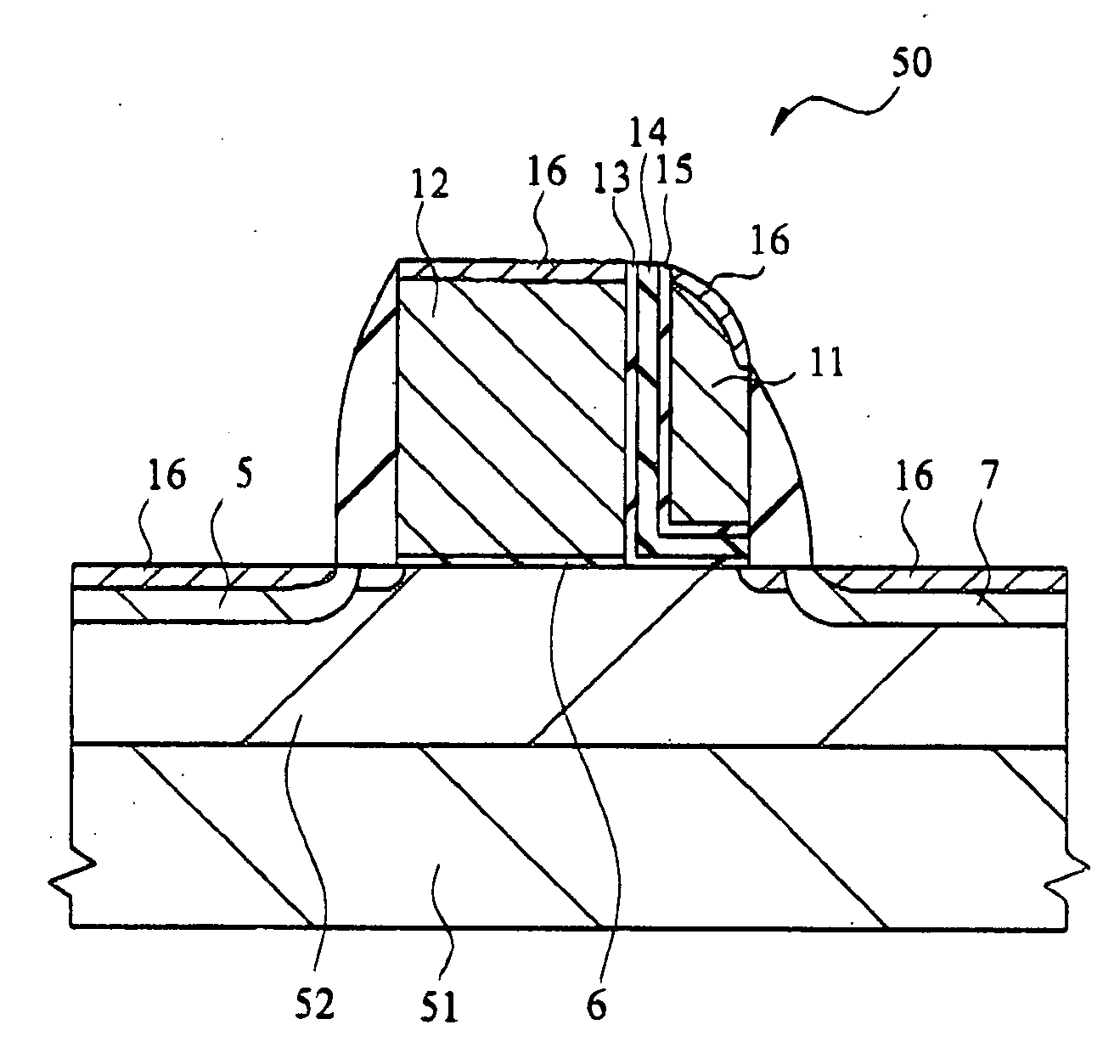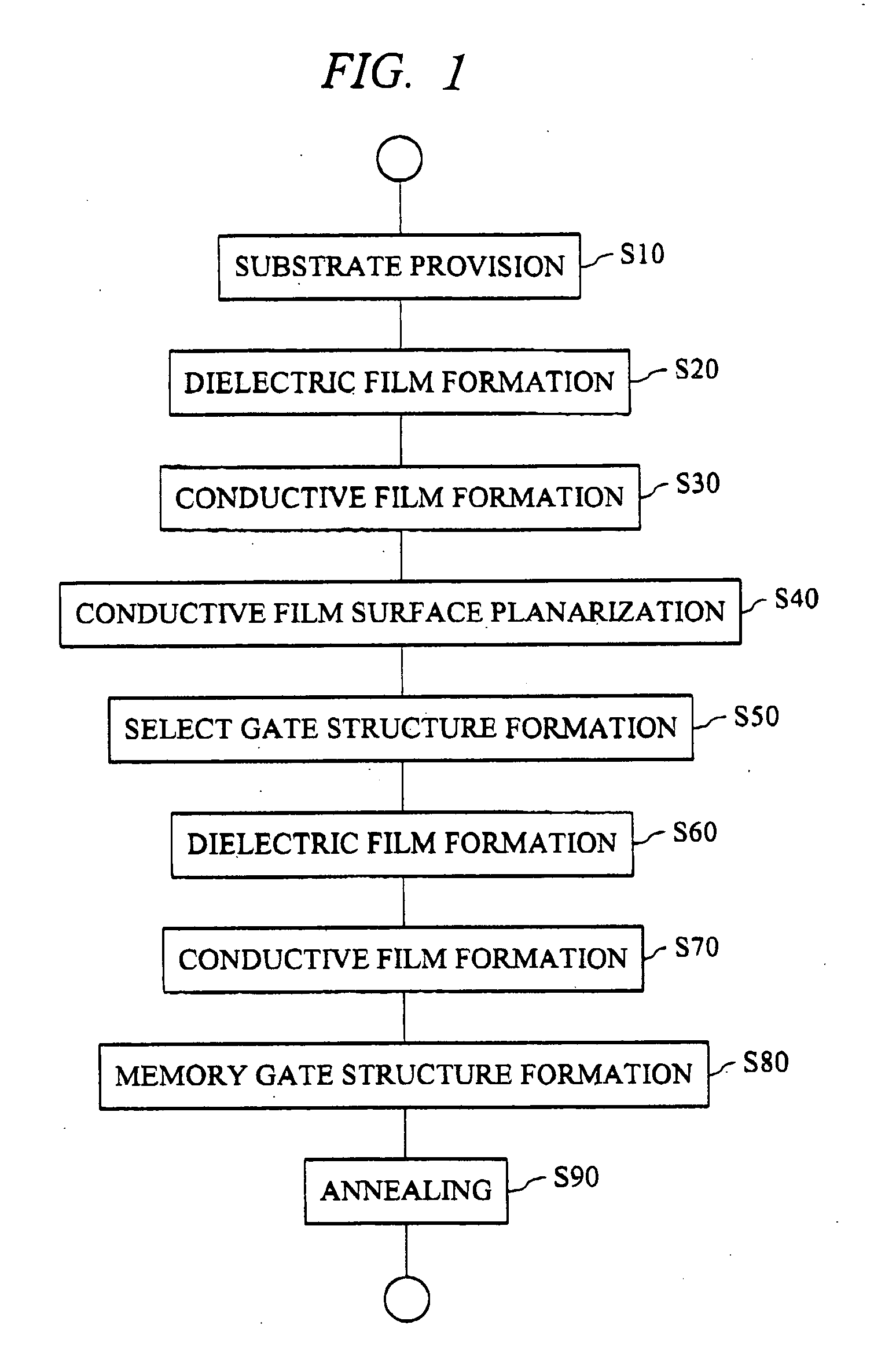Method of fabricating nonvolatile semiconductor memory devices with uniform sidewall gate length
a semiconductor memory and sidewall gate technology, applied in semiconductor devices, instruments, electrical devices, etc., can solve the problems of scaling for the purpose of higher performance and integration approaching its limit, difficult to keep a capacitance coupling ratio, and complex structure, etc., to suppress the leakage of retained charge, good charge retention characteristic, and simple structur
- Summary
- Abstract
- Description
- Claims
- Application Information
AI Technical Summary
Benefits of technology
Problems solved by technology
Method used
Image
Examples
first embodiment
[0084] A fabricating method of a memory cell shown in a first embodiment of the present invention will be described with reference to FIG. 1 to FIG. 6. FIG. 1 is a fabrication flowchart of the memory cell shown in the first embodiment of the present invention, and FIG. 2 to FIG. 6 are explanatory drawings schematically showing the memory cell in the fabricating process. Note that the memory cell is a split gate MONOS memory cell shown in FIG. 17, an array structure is as shown in FIG. 18, and a cell layout is as shown in FIG. 19. A portion surrounded by dotted line 31 in FIG. 19 corresponds to unit memory cell. In adjacent cells, arrangement of a select gate and a memory gate is always symmetrical. Also, the voltage conditions of FIG. 20 are applied to the reading, programming, and erasing operations. Furthermore, a basic fabrication flow confirms to the method described in the “summary of the invention”. A process rule of 150 nm node is used for fabrication.
[0085] First, for examp...
second embodiment
[0096] In a second embodiment, the case where, after the conductive film of the gate electrode material made of polysilicon is formed in the fabricating process of the memory cell shown in the first embodiment, a cap layer made of SiO2 is formed thereon, and the cap layer made of SiO2 is planarized by CMP method will be described.
[0097] The fabricating method of a memory cell shown in the second embodiment of the present invention will be described with reference to FIG. 7 to FIG. 13. FIG. 7 is a fabrication flowchart of the memory cell shown in the second embodiment of the present invention, and FIG. 8 to FIG. 13 are explanatory drawings schematically showing the memory cell in the fabricating process. Note that the basic structure, layout, process rule and the like of the memory cell are the same as those of the first embodiment.
[0098] First, after a semiconductor substrate is prepared, a dielectric film and a conductive film are formed on the semiconductor substrate (not shown)...
third embodiment
[0108] In a third embodiment, the case where the gate length of the select transistor is set to 120 nm or more in the fabricating process of the memory cell shown in the first embodiment will be described.
[0109] The fabricating method of the memory cell shown in the third embodiment will be described with reference to FIG. 14 to FIG. 16. FIG. 14 is a fabrication flowchart of the memory cell shown in the third embodiment of the present invention, and FIG. 15 and FIG. 16 are explanatory drawings schematically showing the memory cell in the fabricating process. Note that the basic structure, layout, process rule and the like of the memory cell are the same as those of the first embodiment.
[0110] First, after a semiconductor substrate is prepared, a dielectric film and a conductive film are formed on the semiconductor substrate (steps S210 to S230). More specifically, a thermal oxide film with a thickness of 3 nm is formed as a dielectric film to be the gate dielectric film of a selec...
PUM
 Login to View More
Login to View More Abstract
Description
Claims
Application Information
 Login to View More
Login to View More - R&D
- Intellectual Property
- Life Sciences
- Materials
- Tech Scout
- Unparalleled Data Quality
- Higher Quality Content
- 60% Fewer Hallucinations
Browse by: Latest US Patents, China's latest patents, Technical Efficacy Thesaurus, Application Domain, Technology Topic, Popular Technical Reports.
© 2025 PatSnap. All rights reserved.Legal|Privacy policy|Modern Slavery Act Transparency Statement|Sitemap|About US| Contact US: help@patsnap.com



